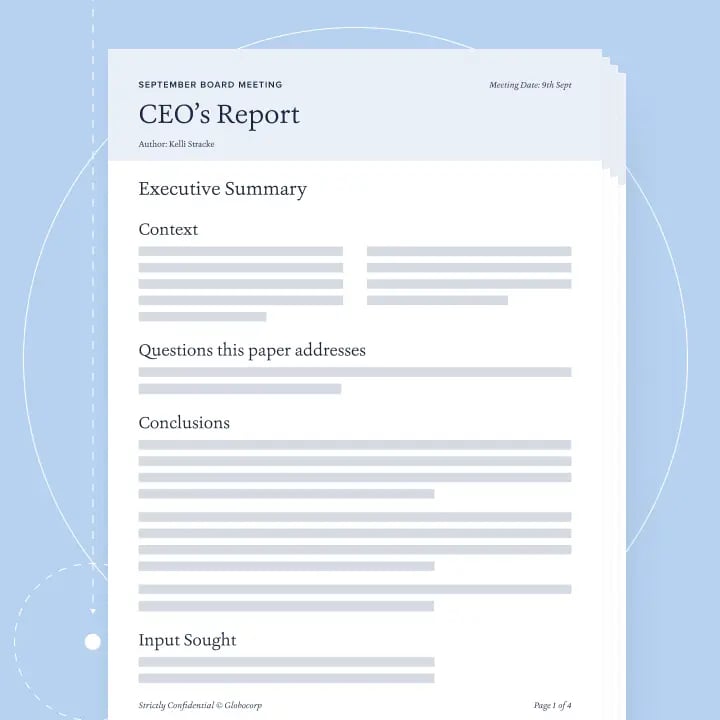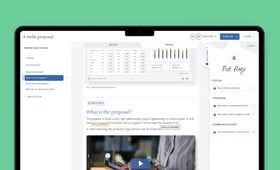Artificial intelligence (AI) tools are no longer reserved for tech geeks alone. With 75% of knowledge workers now using generative AI at work, they’re very much "the new norm" for business.
This means many of us are now applying AI tools to tasks that, just a few months ago, we’d never have considered possible (or even appropriate). Take writing board papers, for example. Almost one in five (19%) of the attendees at a recent Board Intelligence event told us they were already using AI in board reporting, with a further 23% actively exploring it. Of those using or exploring AI tools for board reports, half were using generic generative AI tools like CoPilot and ChatGPT.
With AI tools that can analyze and rephrase text at the click of a button, these report authors could significantly improve the quality and impact of their board papers, from management performance updates to business cases. But using the wrong tools or applying them to the wrong tasks could put you and your organization at risk, by offering up your most sensitive data to other users and bringing “AI hallucinations” into some of your most important internal communications.
In recent months, our team has been immersed in this problem as we’ve built AI features into Lucia, our board and management reporting platform. During that time, we’ve found three specific applications of AI that could help report writers and their organizations make the most of this opportunity to improve their board packs.
Read the definitive guide to AI for the board pack to find out more about how AI works, as well as the common pitfalls of using AI for board packs and how to avoid them.
1. Put the bottom line upfront: Use AI to refine your executive summary
Imagine a colleague is dashing between meetings when they meet you in the corridor. They need you to give them the “in a nutshell” headlines from your board paper. What would you say? That’s your executive summary.
The executive summary is one of the most important ingredients in a high-impact board paper. By condensing the core messages from your report into relevant and actionable takeaways, you help your readers focus on what matters and show them that you can see the bigger picture, too.
AI tools, which are great at summarizing text, can make this difficult task easier. But they are also likely to get things wrong. They don’t understand the context, your market landscape, your organization’s culture, or your audience. Using AI to automate the process away would be irresponsible, because when you do, you outsource the expertise and judgment that the board is expecting to see from you.
Instead, you can use AI to make sure you’ve got the key messages in your executive summary nailed down. Here’s how:
- Write your board paper. For guidance around what to include in your paper, see our “how to” video series, in which we share best practice templates for a range of common board reports.
- Use an AI tool like Lucia’s Auto-Summarization to generate a summary of its key points, based on its analysis of the content of your paper. This summary should be no more than 300 words long.
- Review the AI-generated summary. Does it miss something you thought was key, or include details that aren’t important? The AI tool in this case acts like a mirror, helping you spot and correct gaps or inconsistencies in your report. For example, if it didn’t pick something up in the summary, it could mean that you haven’t made the point as clearly as you thought, or that you’ve gone too deep on less important points. This gives you the chance to edit your paper’s content to ensure that you’ve got the messages and the balance right, before you edit your summary.
- Refine the AI-generated summary to create a version you are confident is accurate and board-relevant. You can read our definitive guide to the executive summary for a detailed “how to” guide.
Harnessing AI in this way means that you can test your analysis of the information you’ve shared and produce a pithy summary for the board, without ever leaving the driver’s seat.
2. Own the message: Use AI to inject candor and balance into your paper
Candor is essential for building trust between the board and management, but it's often missing from board papers. According to our research with the Chartered Governance Institute UK & Ireland, nearly two-fifths of directors think their board papers aren’t upfront enough about the bad news.
It can be tempting to put a positive spin on the story, especially if you’re trying to get the board’s approval for a plan or investment. But there’s always some bad news, and no plan is without risk or challenge. If the bad news or the risks are missing from your paper, your audience will want to know why. As one board member once put it to us, “Until I hear the bad news, I’m not really listening.” Avoiding the uncomfortable truths often only helps draw the board’s attention to them. They’ll question whether you can see the risks and challenges, or wonder if you’re trying to hide something.
On the other hand, when you surface risks or share concerns, you display openness and ownership. This also gives you an opportunity to take action, bringing the issue to the attention of those who can help you tackle it.
AI can help you share the honest, unvarnished insights that your board needs. Lucia’s Candid analysis feature, for example, scans your paper as you write it, analyzing the degree of candor in your paper and sharing a real-time summary with you so you can benchmark the “positivity” of your report against a best practice standard. This gives you a chance to assess whether you’ve struck the right balance and make the necessary changes if you haven’t.
3. Back to the future: Use AI to balance looking backward with looking forward
You can’t drive a car by looking only in the rear-view mirror. You can’t run a business that way either.
Your board paper should reflect this by looking forward, helping board members see what’s ahead. This means thinking about the outlook and the implications of the topic at hand.
When you do this, writing your paper becomes an opportunity to think about the change needed and to flesh out stronger plans. It’s your chance to influence how the organization uses its resources. It also shows your leadership potential. Writing a report that looks both backward and forward marks you out as someone capable of managing the business of today while shaping the business of tomorrow.
However, when we review board packs, they’re often heavily biased towards the recent past. Nearly half (43%) of the directors we’ve surveyed since we started gathering data on board packs in 2019 say their board papers are too backward-looking.
How can AI help? One relatively well-tried option is using AI tools to sift through large volumes of data, looking for trends and patterns, and mapping out a range of potential scenarios to inform your analysis of performance and build out future plans.
When it comes to communicating these insights, AI tools can provide useful feedback on your writing. Lucia’s Forward Analysis tool measures the extent to which your reports contain forward- or backward-looking statements and then compares that to a best practice standard. This helps you assess whether you’ve got the balance right, and gives you an opportunity to correct it.
Our research has identified important ways in which AI can transform the process of writing board papers, from improving executive summaries to pointing out where writing could deliver more forward-looking and candid insights. Whether you’re AI-curious or fully on the bandwagon, it’s clear that this technology is here to stay. And when combined with management’s judgment and experience, it can be a valuable new tool for tackling long-time board pack challenges.




